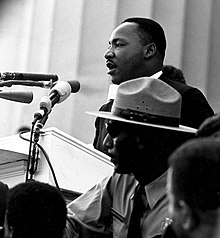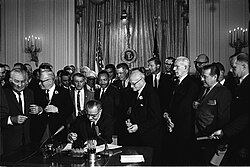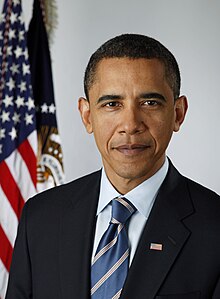Civil Rights Movement
The Supreme Court handed down a landmark decision in the case of Brown v. Board of Education (1954) of Topeka. This decision applied to public facilities, especially public schools. Reforms occurred slowly and only after concerted activism by African Americans. The ruling also brought new momentum to the Civil Rights Movement. Boycotts against segregated public transportation systems sprang up in the South, the most notable of which was the Montgomery Bus Boycott.
Civil rights groups such as the Southern Christian Leadership Conference (SCLC) organized across the South with tactics such as boycotts, voter registration campaigns, Freedom Rides and other nonviolent direct action, such as marches, pickets and sit-ins to mobilize around issues of equal access and voting rights. Southern segregationists fought back to block reform. The conflict grew to involve steadily escalating physical violence, bombings and intimidation by Southern whites. Law enforcement responded to protesters with batons, electric cattle prods, fire hoses, attack dogs and mass arrests.
In Virginia, state legislators, school board members and other public officials mounted a campaign of obstructionism and outright defiance to integration called Massive Resistance. It entailed a series of actions to deny state funding to integrated schools and instead fund privately run "segregation academies" for white students. Farmville, Virginia, in Prince Edward County, was one of the plaintiff African-American communities involved in the 1954 Brown v. Board of Education Supreme Court decision. As a last-ditch effort to avoid court-ordered desegregation, officials in the county shut down the county's entire public school system in 1959 and it remained closed for five years.[166] White students were able to attend private schools established by the community for the sole purpose of circumventing integration. The largely black rural population of the county had little recourse. Some families were split up as parents sent their children to live with relatives in other locales to attend public school; but the majority of Prince Edward's more than 2,000 black children, as well as many poor whites, simply remained unschooled until federal court action forced the schools to reopen five years later.
Perhaps the high point of the Civil Rights Movement was the 1963 March on Washington for Jobs and Freedom, which brought more than 250,000 marchers to the grounds of the Lincoln Memorial and the National Mall in Washington, D.C., to speak out for an end to southern racial violence and police brutality, equal opportunity in employment, equal access in education and public accommodations. The organizers of the march were called the "Big Six" of the Civil Rights Movement: Bayard Rustin the strategist who has been called the "invisible man" of the Civil Rights Movement; labor organizer and initiator of the march, A. Phillip Randolph; Roy Wilkins of the NAACP; Whitney Young, Jr., of the National Urban League; Martin Luther King, Jr., of the Southern Christian Leadership Conference (SCLC); James Farmer of the Congress on Racial Equality (CORE); and John Lewis of the Student Nonviolent Coordinating Committee (SNCC). Also active behind the scenes and sharing the podium with Dr. King was Dorothy Height, head of the It was at this event, on the steps of the Lincoln Memorial, that King delivered his historic "I Have a Dream" speech.
This march, the 1963 Birmingham Children's Crusade, and other events were credited with putting pressure on President John F. Kennedy, and then Lyndon B. Johnson, that culminated in the passage the Civil Rights Act of 1964 that banned discrimination in public accommodations, employment, and labor unions.
The "Mississippi Freedom Summer" of 1964 brought thousands of idealistic youth, black and white, to the state to run "freedom schools", to teach basic literacy, history and civics. Other volunteers were involved in voter registration drives. The season was marked by harassment, intimidation and violence directed at civil rights workers and their host families. The disappearance of three youths, James Chaney, Andrew Goodman and Michael Schwerner in Philadelphia, Mississippi, captured the attention of the nation. Six weeks later, searchers found the savagely beaten body of Chaney, a black man, in a muddy dam alongside the remains of his two white companions, who had been shot to death. There was national outrage at the escalating injustices of the "Mississippi Blood Summer", as it by then had come to be known, and at the brutality of the murders.
In 1965 the Selma Voting Rights Movement, its Selma to Montgomery marches, and the tragic murders of two activists associated with the march, inspired President Lyndon B. Johnson to call for the full Voting Rights Act of 1965, which struck down barriers to black enfranchisement. In 1966 the Chicago Open Housing Movement, followed by the passage of the 1968 Fair Housing Act, was a capstone to more than a decade of major legislation during the civil rights movement.
By this time, African Americans who questioned the effectiveness of nonviolent protest had gained a greater voice. More militant black leaders, such as Malcolm X of the Nation of Islam and Eldridge Cleaver of the Black Panther Party, called for blacks to defend themselves, using violence, if necessary. From the mid-1960s to the mid-1970s, the Black Power movement urged African Americans to look to Africa for inspiration and emphasized black solidarity, rather than integration.
Post Civil Rights era of African-American history
Politically and economically, blacks have made substantial strides in the post-civil rights era. Civil rights leader Jesse Jackson, who ran for the Democratic Party's presidential nomination in 1984 and 1988, brought unprecedented support and leverage to blacks in politics.
In 1989, Douglas Wilder became the first African-American elected governor in U.S. history. In 1992 Carol Moseley-Braun of Illinois became the first black woman elected to the U.S. Senate. There were 8,936 black officeholders in the United States in 2000, showing a net increase of 7,467 since 1970. In 2001 there were 484 black mayors.
The 39 African-American members of Congress form the Congressional Black Caucus, which serves as a political bloc for issues relating to African Americans. The appointment of blacks to high federal offices—including General Colin Powell, Chairman of the U.S. Armed Forces Joint Chiefs of Staff, 1989–93, United States Secretary of State, 2001–05; Condoleezza Rice, Assistant to the President for National Security Affairs, 2001–04, Secretary of State in, 2005–09; Ron Brown, United States Secretary of Commerce, 1993–96; and Supreme Court justices Thurgood Marshall and Clarence Thomas—also demonstrates the increasing visibility of blacks in the political arena.
Economic progress for blacks' reaching the extremes of wealth has been slow. According to Forbes richest lists, Oprah Winfrey was the richest African American of the 20th century and has been the world's only black billionaire in 2004, 2005, and 2006.[167] Not only was Winfrey the world's only black billionaire but she has been the only black on the Forbes 400 list nearly every year since 1995. BET founder Bob Johnson briefly joined her on the list from 2001 to 2003 before his ex-wife acquired part of his fortune; although he returned to the list in 2006, he did not make it in 2007. With Winfrey the only African American wealthy enough to rank among America's 400 richest people,[168] blacks currently comprise 0.25% of America's economic elite and comprise 13% of the U.S. population.
The dramatic political breakthrough came in the 2008 election, with the election of Barack Obama, the son of a black Kenyan father and a white American mother. He won overwhelming support from African-American voters in the Democratic primaries, even as his main opponent Hillary Clinton had the support of many black politicians. African Americans continued to support Obama throughout his term.[169] After completing his first term, Obama ran for a second term. In 2012, he won the presidential election against candidate Mitt Romney and was re-elected as the president of the United States.
The post-civil rights era is also notable for the New Great Migration, in which millions of African Americans have returned to the South including Texas, Georgia, Florida and North Carolina, often to pursue increased economic opportunities in now-desegregated southern cities.
The Blues Brothers (film)
Jump to navigation Jump to search| The Blues Brothers | |
|---|---|
 Theatrical release poster | |
| Directed by | John Landis |
| Produced by | Robert K. Weiss |
| Written by |
|
| Starring | |
| Cinematography | Stephen M. Katz |
| Edited by | George Folsey Jr. |
| Distributed by | Universal Pictures |
Release date |
|
Running time | 133 minutes[1] |
| Country | United States |
| Language | English |
| Budget | $30 million[2] |
| Box office | $115.2 million[3] |
The Blues Brothers is a 1980 American musical comedy film directed by John Landis.[4] It stars John Belushi and Dan Aykroyd as "Joliet" Jake and Elwood Blues, characters developed from "The Blues Brothers" recurring musical sketch on the NBC variety series Saturday Night Live. The film is set in and around Chicago, Illinois, where it was filmed. The film's screenplay was written by Aykroyd and Landis. It features musical numbers by rhythm and blues (R&B), soul, and blues singers James Brown, Cab Calloway, Aretha Franklin, Ray Charles, and John Lee Hooker. It features non-musical supporting performances by Carrie Fisher, Henry Gibson, Charles Napier and John Candy.
The story is a tale of redemption for paroled convict Jake and his blood brother Elwood, who set out on "a mission from God" to save the Catholic orphanage in which they were raised from foreclosure. To do so, they must reunite their R&B band and organize a performance to earn $5,000 needed to pay the orphanage's property tax bill. Along the way, they are targeted by a homicidal "mystery woman", Neo-Nazis, and a country and western band—all while being relentlessly pursued by the police.
Universal Studios, which had won the bidding war for the film, was hoping to take advantage of Belushi's popularity in the wake of Saturday Night Live, Animal House, and the Blues Brothers' musical success; it soon found itself unable to control production costs. The start of filming was delayed when Aykroyd, new to film screenwriting, took six months to deliver a long and unconventional script that Landis had to rewrite before production, which began without a final budget. On location in Chicago, Belushi's partying and drug use caused lengthy and costly delays that, along with the destructive car chases depicted onscreen, made the final film one of the most expensive comedies ever produced.
Concerns that the film would fail limited its initial bookings to less than half those a film of its magnitude normally received. Released in the United States on June 20, 1980, it received mostly positive reviews. It earned just under $5 million in its opening weekend and went on to gross over $115 million in theaters worldwide before its release on home video. It has become a cult classic, spawning the sequel, Blues Brothers 2000, 18 years later, which was a critical and commercial failure.


